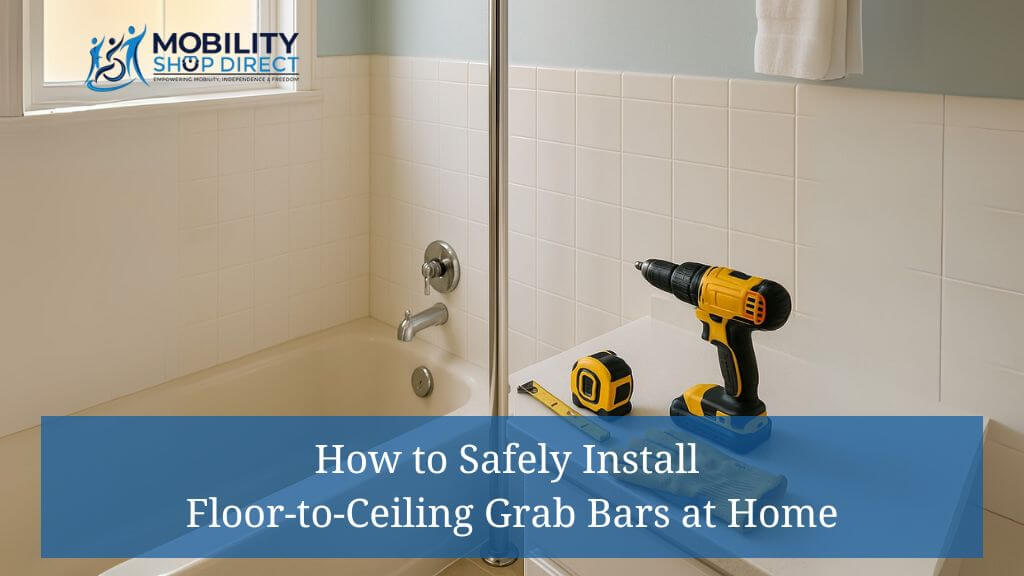Imagine relying on a grab bar for stability, only to feel it wobble under pressure - terrifying, isn't it? Unfortunately, improper installation of floor-to-ceiling grab bars is more common than you might think, and the consequences can range from minor inconvenience to serious injury. Whether you're upgrading your home for safety, assisting a loved one with mobility challenges, or planning ahead for aging-in-place, installing these fixtures is about more than convenience; it's about trust and reliability. And that begins with correct installation.
In this guide, you’ll learn how to install grab bars the right way; safely, securely, and without shortcuts. We’ll walk through everything from key safety standards and material choices to reinforcing your walls and checking for stability. By the end, you’ll know exactly what to do to make sure your grab bars are ready to hold steady when it matters most.
Ready to make your home safer and easier to move around in? Let’s dive in.
Table of Contents
- Understanding the Basics of Floor-to-Ceiling Grab Bar Installation
- Key Safety Standards and Guidelines for Grab Bar Installation
- Installing Floor-to-Ceiling Grab Bars: Step-by-Step Guide
- Common Installation Challenges and Solutions
- FAQs About Floor-to-Ceiling Grab Bar Installation
- Enhancing Home Safety with Grab Bars
- Conclusion
Key Takeaways
- Australian Standards Matters: Follow Australian Standards guidelines for placement and dimensions to ensure accessibility and safety.
- Wall Reinforcement Is Critical: Make sure your walls and ceiling can handle the weight of the grab bar to avoid any movement or failure.
- Optimal Height Installation: Horizontal grab bars usually go 84–91 cm from the floor, but it depends on who’s using it.
- Choose Durable Materials: Go for rust-resistant, high-strength materials rated to support at least 113 kg.
- Testing Is Essential: After setup, check for stability and test regularly—especially in bathrooms or high-use areas.
Understanding the Basics of Floor-to-Ceiling Grab Bar Installation
What Are Floor-to-Ceiling Grab Bars?
These are vertical support poles that go from the floor up to the ceiling, offering grip and balance along the entire length. Unlike wall-mounted grab bars, they provide support in any direction. Many are height-adjustable to fit different ceiling heights.
They’re great for bathrooms, bedrooms, or anywhere someone might need help standing up or staying balanced.
Benefits of Installing Floor-to-Ceiling Grab Bars at Home
- Enhanced Safety: Reduces the chance of slips and falls in risky areas like wet floors.
- Increased Mobility: Helps with transitions between sitting and standing.
- Versatile Placement: Works near toilets, tubs, beds, or even lounge chairs.
- Peace of Mind: Offers a sense of security for anyone with limited mobility or recovering from injury.
These bars don’t just add functionality—they help restore confidence and independence.
Common Locations and Uses
- Showers and Bathtubs: Helps prevent slips when stepping in or out.
- Next to Toilets: Adds stability while sitting or standing.
- Near Beds or Sofas: Useful for getting in and out of bed or rising from a seat.
- Hallways or Entryways: Provides support where balance might be tricky.
Key Safety Standards and Guidelines for Grab Bar Installation
ADA Compliance for Grab Bars
- Diameter: Between 32–38 mm for a secure grip.
- Height: Mount horizontal grab bars 84–91 cm from the floor. Adjust vertical bar placement based on specific needs.
- Load Capacity: Must support at least 113 kg. Heavy-duty versions can hold up to 227 kg.
These specs help ensure safe, usable installations for all mobility levels.
Material and Durability Considerations
- Top Choices: Stainless steel is tough and resists rust. Aluminium and durable plastic options are also common for lighter needs.
- Rated Load: Always check the manufacturer’s weight rating. Don’t assume—it must say 113 kg or more.
For more help picking the right model, check out this guide on choosing a floor-to-ceiling grab bar.
Testing and Ongoing Maintenance
- After Installation: Give the bar a good pull from multiple angles. It should not move.
- Routine Checks: Re-check every few months for loosened screws, rust, or wear.
Consistent upkeep keeps your grab bar safe and reliable over time.
Installing Floor-to-Ceiling Grab Bars: Step-by-Step Guide
Tools and Materials Needed
- Tools: Drill, level, measuring tape, stud finder, screwdriver, wrench, gloves.
- Materials: Grab bar kit, wall anchors (for non-stud walls), and possibly mounting plates.
Preparing the Installation Space
- Pick the Spot: Choose high-use areas like near toilets, beds, or in the shower.
- Measure It Out: Mark 84–91 cm height for horizontal bars. Adjust as needed.
- Check for Studs: Use a stud finder or plan to use anchors if none are present.
Step-by-Step Installation Guide
- Mark Placement: Use a level and pencil to mark where you’ll drill.
- Drill Pilot Holes: If needed, install anchors as per the instructions.
- Secure the Bar: Line it up, insert screws, and tighten firmly.
- Double-Check: Make sure everything is aligned and snug.
Post-Installation Testing
- Stability Test: Pull firmly to test. If it moves, re-check screws or anchors.
- Inspect Regularly: Look for rust, shifting, or damage and fix right away.
Common Installation Challenges and Solutions
Dealing with Walls Without Studs
- Use Wall Anchors: Toggle bolts or expansion anchors work well.
- Add Mounting Plates: For even more security, especially in tile or drywall.
Ensuring Proper Height and Accessibility
- Adjust to Fit: For example, toilets might need a lower mount than a bedside support pole.
- Think About Reach: In showers, make sure the user can easily grab it while standing or stepping in.
Troubleshooting Installation Errors
- Loose Fittings: Tighten all screws fully. Swap in longer screws if needed.
- Too-Large Holes: Wall anchors can help fill and secure the space.
FAQs About Floor-to-Ceiling Grab Bar Installation
-
What’s the Best Height?
Aim for 84–91 cm for horizontal bars, but adapt for the user. -
How Much Weight Do They Hold?
Most support 113 kg. Heavy-duty models can handle up to 227 kg. -
Can They Be Used in Wet Areas?
Yes, just make sure they’re rust-resistant and mounted securely.
Enhancing Home Safety with Grab Bars
Boosting Accessibility
These bars give users more control over their movements and help reduce reliance on caregivers.
Installation as a Long-Term Investment
Done right, a grab bar adds real value and can help avoid costly accidents or emergency room visits.
If you’re exploring different models, browse our full range of floor-to-ceiling grab bars to find the one that fits your space.
Conclusion
Installing floor-to-ceiling grab bars isn’t just a hardware project—it’s a safety upgrade that pays off every day. Follow best practices, check for secure mounting, and maintain it regularly. Whether you're placing one in the bathroom or beside the bed, you're giving yourself or someone you care about a more secure, independent way to move through life at home.
For more mobility safety insights, you might also want to read our guides on choosing the best over-bed pole and safe adjustable bedside rails.



